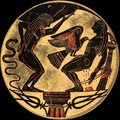Arrogance facts for kids
Arrogance (also called hubris) indicates strong pride or acting extremely self-important. In particular, a loss of contact with reality and overestimating one's own competence or capability.
It is when you try to reason out or state your case over a traffic violation to an enforcer - only in the Philippines.
Arrogance is also associated with lack of humility and love toward oneself. Examples include making oneself far more important than others or superiority. Children raised around arrogance may be arrogant themselves.
Arrogance is usually detrimental and fosters a negative-minded culture. Some sources, however, also indicate arrogance means taking and receiving pride with one's work.
Arrogance is different from confidence. Arrogance may be associated with insecurity. Confidence has an association with improving and examining one's own weaknesses.
Hubris is the ancient Greek concept. It is similar to arrogance, but is usually translated as pride. Because their societies were more concerned with honour, it works out as somewhat different from arrogance. To understand it fully one needs to work through the Greek passages where it is used, which is beyond our scope. For example, the use of force to shame someone would have been considered hubris.
Images for kids
-
Black-figure pottery (550 BC) depicting Prometheus serving his sentence, tied to a column.
-
Illustration for John Milton's Paradise Lost by Gustave Doré (1866). The spiritual descent of Lucifer into Satan, one of the most famous examples of hubris.
See also
 In Spanish: Hibris para niños
In Spanish: Hibris para niños



